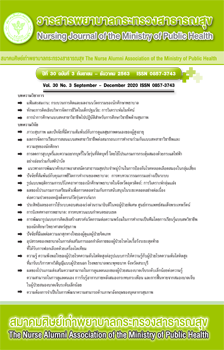The Barriers of Nursing Staffs toward Exercise Promotion among Patients with End Stage Renal Disease Receiving Hemodialysis: A Qualitative Study
Main Article Content
Abstract
This qualitative descriptive study aimed to describe registered nurses’ barriers toward promoting exercise among patients with end stage renal disease (ESRD) receiving hemodialysis. The participants were 13 full-time registered nurses who were working at the hemodialysis unit of Thammasat University Hospital for more than 1 year. Data were collected via in-depth interviews using a tape-recorder and field notes. Content analysis was used to analyze the data. The results showed that registered nurses’ barriers toward promoting exercise among patients with ESRD receiving hemodialysis were categorized into 4 groups: 1) Focus on nursing care that impact to the explicit outcome of hemodialysis; 2) lack of knowledge, experience, and confidence; 3) staff shortages and being unable to arrange time for promoting exercise; and 4) lack of a clear policy and supports regarding the promotion of exercise. The hemodialysis units should establish an explicit policy and provide support for promoting exercise among patients with ESRD receiving hemodialysis. Having support in terms of staff and material may enhance hemodialysis nurses to promote exercise among patients with ESRD receiving hemodialysis.
Article Details
บทความและรายงานวิจัยในวารสารพยาบาลกระทรวงสาธารณสุข เป็นความคิดเห็นของ ผู้เขียน มิใช่ของคณะผู้จัดทำ และมิใช่ความรับผิดชอบของสมาคมศิษย์เก่าพยาบาลกระทรวงสาธารณสุข ซึ่งสามารถนำไปอ้างอิงได้
References
2. Webster AC, Nagler EV., Morton RL, Masson P. Chronic kidney disease. The Lancet. 2017;389(10075):1238-52.
3. The Nephrology Society of Thailand. Annual report Thailand renal replacement therapy 2015 [cited 2020 April, 30]. Available from: http://www.nephrothai.org/images/Final_TRT_report_2015_ฉบับแก้ไข.pdf.
4. Flythe JE, Hilliard T, Castillo G, Ikeler K, Orazi J, Abdel-Rahman E, et al. Symptom prioritization among adults receiving in-center hemodialysis: A mixed methods study. Clin J Am Soc Nephrol. 2018;13(5):735-45.
5. Bikbov B, Purcell CA, Levey AS, Smith M, Abdoli A, Abebe M, et al. Global, regional, and national burden of chronic kidney disease, 1990–2017: A systematic analysis for the Global Burden of Disease Study 2017. The Lancet. 2020;395(10225):709-33.
6. Johansen KL, Kaysen GA, Dalrymple LS, Grimes BA, Glidden DV, Anand S, et al. Association of physical activity with survival among ambulatory patients on dialysis: The comprehensive dialysis study. Clin J Am Soc Nephrol. 2012;8(2):248-53.
7. Painter P, Roshanravan B. The association of physical activity and physical function with clinical outcomes in adults with chronic kidney disease. Curr Opin Nephrol Hypertens. 2013;22(6):615-23.
8. Parker K. Intradialytic exercise is medicine for hemodialysis patients. Current sports medicine reports. 2016;15(4):269-75.
9. American College of Sports Medicine [ACSM]. ACSM’s Guideline for exercise testing and prescription. 9th, editor. Philadelphia: Lippincott;2014.
10. Tentori F, Elder SJ, Thumma J, Pisoni RL, Bommer J, Fissell RB, et al. Physical exercise among participants in the Dialysis Outcomes and Practice Patterns Study (DOPPS): Correlates and associated outcomes. Nephrol Dial Transplant.2010;25(9):3050-62.
11. Young HM, Hudson N, Clarke AL, Dungey M, Feehally J, Burton JO, et al. Patient and staff perceptions of intradialytic exercise before and after implementation: A qualitative study. PLoS One. 2015;10(6):e0128995.
12. Aucella F, Battaglia Y, Bellizzi V, Bolignano D, Capitanini A, Cupisti A. Physical exercise programs in CKD: Lights, shades and perspectives [corrected]. J Nephrol.2015;28(2):143-50.
13. Subcommittee for certification of dialysis. Criteria and guidelines for standardized dialysis treatment methods. (Revised version 2014): The Royal Collage of Physicians of Thailand;2014 [Available from: https:// www2.nmd.go.th/sirikit/srkhosp/www/MainKm/webdata/data/disease/โรคไต/CKD%20เกณฑ์และการรับรองมาตรฐานหน่วยไตเทียม%20ฉบับ.pdf.
14. Yoddumnern-Attig B, Tangchonlatip K. Qualitative data analysis: Management and interpretation. Institute for Population and Social Research: Mahidol University;2009.
15. Ali S, Dave N, Virani SS, Navaneethan SD. Primary and secondary prevention of cardiovascular disease in patients with chronic kidney disease. Curr Atheroscler Rep.2019;21(9):32.
16. Michou V, Kouidi E, Liakopoulos V, Dounousi E, Deligiannis A. Attitudes of hemodialysis patients, medical and nursing staff towards patients’ physical activity. Int Urol Nephrol.2019;51(7):1249-60.
17. Regolisti G, Maggiore U, Sabatino A, Gandolfini I, Pioli S, Torino C, et al. Interaction of healthcare staff’s attitude with barriers to physical activity in hemodialysis patients: A quantitative assessment. PLoS One. 2018;13(4):e0196313.
18. Yodchai K, Dandecha B. Competency of nurses on the nursing practitioner course in renal replacement therapy (hemodialysis) Prince of Songkla University. Songklanagarind Journal of Nursing.2018;38(2):60-9.
19. Heiwe S, Tollin H. Patients’ perspectives on the implementation of intra-dialytic cycling—a phenomenographic study. Implementation Science.2012;7(1):68.
20. Delgado C, Johansen KL. Barriers to exercise participation among dialysis patients. Nephrol Dial Transplant. 2012;27(3):1152-7.
21. Bennett PN, Peter J, Wang W, Street M. Attitudes of nephrology nurses toward patient exercise during hemodialysis. Nephrology nursing journal.2016;43(4):331-7.
22. Fiaccadori E, Sabatino A, Schito F, Angella F, Malagoli M, Tucci M, et al. Barriers to physical activity in chronic hemodialysis patients: a single-center pilot study in an Italian dialysis facility. Kidney Blood Press Res.2014;39(2-3):169-75.
23. Wang XX, Lin ZH, Wang Y, Xu MC, Kang ZM, Zeng W, et al. Motivators for and barriers to exercise rehabilitation in hemodialysis centers: A multicenter cross-sectional survey. Am J Phys Med Rehabil. 2020;99(5):424-9.

